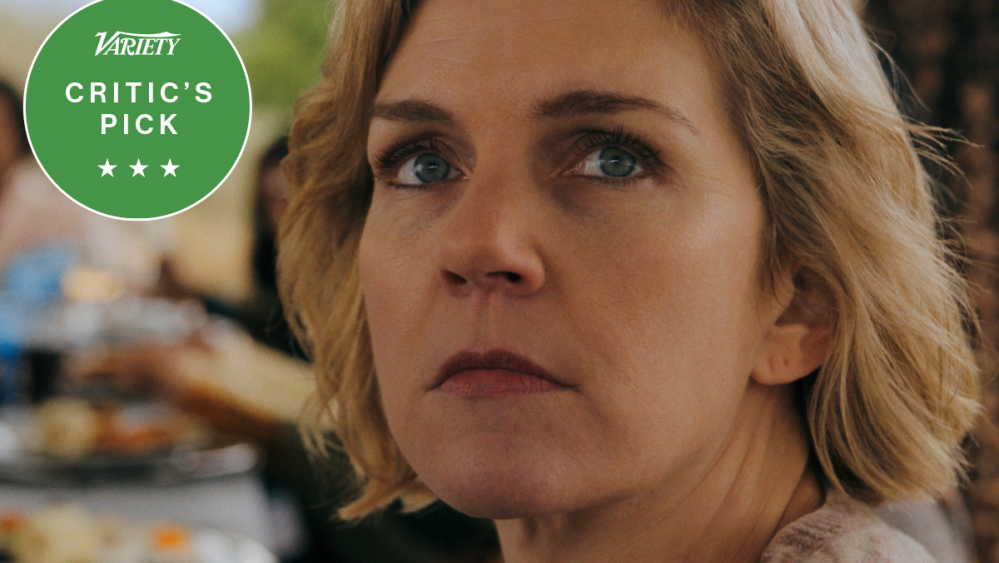Copyright Variety

SPOILER WARNING: The following review describes the basic premise of “Pluribus,” but keeps other plot details under wraps to preserve the viewing experience. There’s a lot I can’t tell you about “Pluribus,” the highly anticipated Apple TV drama that marks creator Vince Gilligan’s first venture outside the “Breaking Bad” universe in more than a decade. “Pluribus” is also the “X-Files” alumnus’ return to science fiction, a genre that adds an air of mystery to the already sky-high expectations that come with Gilligan’s CV. Apple considers even the most basic synopsis of the plot to be a spoiler, so I’ll hold off on one for now. Instead, I’ll start with what I can say about “Pluribus” without being coy, which is just how good Rhea Seehorn is in it. To many viewers, Seehorn was the great discovery of “Better Call Saul,” AMC’s “Breaking Bad” prequel that was both less accessible and more rewarding than its predecessor. Bob Odenkirk’s slick-talking Saul Goodman was already a known quantity, if not his original identity Jimmy McGill; as Jimmy’s colleague-turned-love-interest Kim Wexler, Seehorn gave her partner’s moral decay real stakes, and turned potentially dry, legalistic plots into riveting television. Heading into “Pluribus,” you already know why Gilligan would want to build an entire show around an actor of Seehorn’s caliber. But it’s only by watching “Pluribus” that you understand why this concept would basically only work with Seehorn at its forefront. (In addition to topping the call sheet, Seehorn also executive produces.) She is the sine qua non of the entire enterprise — its center, its selling point, its load-bearing foundation. The show may be Gilligan’s blank-check moment, spending the proceeds of several hundred thousand iPhone sales on a big, epic swing. But it’s also Seehorn’s party, and she makes for an excellent host. Here’s where I have to get specific about the how and why, and give a final warning to spoiler hardliners. (Feels a little silly when you can get the gist from the trailer and Wikipedia, but rules are rules!) Seehorn plays Carol Sturka, a best-selling romance author who becomes exceptional in an entirely different way when the world undergoes “The Joining,” a process that begins in a top-secret military lab and spreads until every person on Earth is connected by what the resulting collective consciousness calls “psychic glue.” Well, almost every person on Earth. Carol is immune, and understandably upset when her partner Helen (Miriam Shor) becomes one of almost a billion casualties as The Joining takes effect. You have to break a few eggs to make one giant, unified mega-omelet. This means “Pluribus” has essentially two characters: Carol, and everyone else. Hence why Seehorn, beloved by “Better Call Saul” fans but by no means a household name, is by far the most recognizable face in the cast, with due respect to recent Emmy winner Jeff Hiller. The hive mind created by the Joining has no name, prefacing many introductions with “this individual is known as…”; when Carol asks who they mean by “we,” they respond: “We is us. Just ‘us.’” Anonymity is a necessary prerequisite for setting the scene, barring a celebrity cameo or two to make a joke about the once famous individuals now transformed into obliging worker bees. The first hour of “Pluribus” plays out like the apocalyptic horror the Joining sure sounds like when you describe it. Gilligan may not have spent his Apple budget on casting movie stars, but in directing the first couple of episodes, he leverages the global scope of the “Pluribus” concept into a vast and ominous sense of collapse. Carol and Helen witness a car crash outside a bar, clueing them in that something’s wrong; an upended ambulance tells Carol there’s no help on its way. The number of extras required to give a sense of the scale is mind-boggling, let alone the blocking required to make them move in perfect, terrifying synchronicity. But once Carol starts to grasp the new normal, “Pluribus” becomes something more interesting and even-keeled than a struggle to survive. Gilligan may be returning to the same sci-fi register as his early career, yet there’s a clear carryover from “Better Call Saul” in the deliberate, patient pace of the episodes after panic and fear give way to silence and stillness. (There’s continuity behind the camera, too; many of the credited writers, like executive producers Gordon Smith and Alison Tatlock, are “Saul” veterans.) Humanity’s newly pooled personality is not malicious. Any violence caused by its creation was accidental, and it describes the impulse to absorb new individuals as a “biological imperative, like breathing.” These aren’t ravenous zombies, or sinister automatons. They’re calm, affable, eager to help and make Carol absolutely insane. Carol shares the wary intelligence that made Kim Wexler so captivating, but she’s more volatile than Kim ever was. (To be fair, while Kim saw some crazy shit in her time, she never lived through the end of individuality as a concept.) A misanthrope by nature, she reacts to the omni-person’s friendly sincerity with the same angry mistrust she once felt toward her readers, who embraced a purple-prosed pirate romance Carol herself found schlocky. When the Joined, having gleaned all of Helen’s memories and knowledge before she died, send an emissary named Zosia (Karolina Wydra) who looks exactly like the inspiration for the romantic hero in Carol’s novels, it has the opposite of the intended conciliatory effect. “Pluribus” doesn’t have the same mystery box feel as “Severance,” its closest analog in the current Apple roster, though it invites plenty of questions, such as: What do the Joined want? Do they have some plan for what to do with all their pooled mental resources? And most pressingly for the lonely, furious Carol, is there a way to undo this sudden, total change? There are also broader, more interpretive inquiries, like exactly what ideas Gilligan is getting at here. Is the Joining a metaphor for how AI and the algorithms are eroding our sense of self with comforting convenience? Or is “Pluribus” more of a pure philosophical debate between the risks of freedom and the reassurance of belonging? Zosia compares seeing Carol’s misery and wanting to subsume her to the instinct to save a drowning stranger. Seehorn’s presence is so magnetic here it both channels these themes and pushes them to the side. Alone in Albuquerque — still Gilligan’s home base, even as his ambitions have widened outward — Carol buckles under her grief, steels herself with determination, lashes out and makes do. She’s funny and pitiful, prickly and vulnerable. I could watch her smash golf balls through the windows of abandoned buildings all day. “Pluribus” can have the feel of an acting exercise, both for Seehorn and her manifold scene partners. That’s not a criticism; it’s a joy for a production this big to have such an experimental, risk-taking slant, and for a talent like Seehorn to get the canvas it deserves. You don’t necessarily miss the presence of a full, traditional cast, even as Carol admits she does miss her friends and neighbors. Hell may be other people, but to her, hell is really other people all combined into one mega-person. The first two episodes of “Pluribus” will premiere on Apple TV on Nov. 7, with remaining episodes streaming weekly on Fridays.



